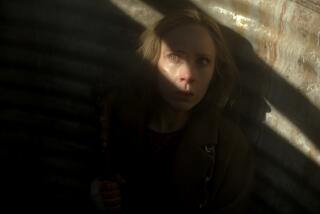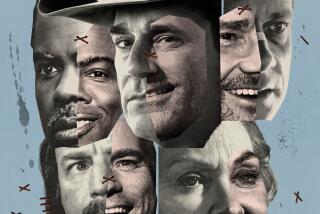Fargo Hip? You Betcha
- Share via
FARGO, N.D. — The gift shop at the four-gate airport here sells the obligatory coffee mugs emblazoned with “Yah, you betcha.” It also sells posters with moody black-and-white photos of great cities of the world: Moscow. London. Paris. Fargo.
It’s no joke.
Or at least, not much of one.
The Coen brothers’ grisly comedy “Fargo” cursed this city with a dreary reputation. Just one scene in the 1996 film takes place here. Yet Fargo became fixed in the public imagination as a frozen wasteland of seedy bars and hick accents.
The frozen part is undeniably accurate; the thermometer read minus 27 the other day, and a prairie wind was howling. But wasteland? Look again.
In the last three years, Fargo has begun to reinvent itself as improbably stylish, worldly, even luxurious -- to the point where the mayor has hopes of marketing the city as a vacation destination. Quietly, subversively, Fargo has gone trendy.
Oh, there are still plenty of dank bars where tap beer goes for 75 cents. And yes, a $500,000 condo downtown does sit just a block from the Valley Gun & Pawn Shop. But all along the two main downtown streets, hip restaurants, cafes and galleries beckon.
There’s even a martini bar that serves sushi.
OK, it’s just once a month. But still. In a stubbornly steak-and-potatoes state, that’s noteworthy. Local menus burst with other culinary adventures as well, from dandelion salad to Asian gazpacho with cilantro cream, from rabbit loin to custard made from thorny green durian fruit imported from Vietnam.
“If I had to pick one adjective for what downtown Fargo was like 10 years ago, I would say ‘sleazy,’ ” said Laurie Baker, 50, a yoga teacher. “Now, I would say, ‘getting cosmopolitan.’ We’re not quite there yet. But we’re getting there.”
To reach this point, the city has spent $9 million to improve downtown’s look, primarily by ripping out dingy, three-decade-old awnings that shrouded the sidewalks in perpetual gloom. Even the railroad crossings will be reconfigured, so residents won’t have to put up with 85 ear-blasting train whistles a day.
Private investment has been encouraged with a Renaissance Zone. Development in the downtown core is exempt from property tax for five years; owners and tenants enjoy a five-year holiday from state and local income tax.
The result: In the last three years, 65 projects have been launched, transforming boarded-up tractor factories into offices, lofts, even an art museum. The properties had a combined value of less than $8 million when the work started. By the time they come back on the tax rolls, they’re expected to be worth nearly $34 million.
Developers knew they wouldn’t be able to woo Fargoans downtown with more of the same chain stores and franchise restaurants that are replicated every few blocks in the suburbs. So they set about creating distinctive boutiques and artsy hangouts -- the kind of places that residents in this city of 90,000 used to go to Minneapolis or Chicago to find.
Barbara’s Deli doubles as an antique shop, crammed with wood chests and country-cute knickknacks. At Monte’s, a sultry lounge with maroon walls, bartender Aaron Hennings concocts 35 specialty martinis.
And pastry chef Nichole Secker converted a 1950s-style diner into a butter-scented Parisian cafe. No longer can a caramel roll from the supermarket pass for fresh pastry in Fargo; Secker is at her silver mixing bowls early each morning to make lemon curd tarts and mocha mousse towers.
“I just felt we deserved a little ... pick an adjective. A little more eclectic fare,” she said.
“Fargo’s looking up,” said Gabe Larson, 64, who has been cutting hair in the Golden Razor barbershop downtown for nearly half a century.
Certainly, the improvements are patchy. Vacant storefronts still gape here and there; an adult bookstore still entices with XXX movies. But every month, coffee houses and specialty shops open downtown, their red brick facades restored to their century-old splendor. An Art Deco cinema brings in offbeat films and live theater -- and packs the house for midnight showings of classic movies.
Living in Luxury
From a warehouse so long abandoned that icicles hung from the basement ceiling in winter, developer John Dalen has carved out 11 luxury condos. Most are priced around $300,000. The showpiece, though, is a half-a-million-dollar, 5,000-square-foot loft with two fireplaces, hardwood floors, vaulted ceilings and 18-foot-high atrium windows. It’s already been snapped up, months before it will be ready for occupation. In fact, all but two units have been sold -- and Dalen said several bidders are vying for those.
“We had some real naysayers when we told our friends we were moving downtown,” said Cathy Rice, a mortgage broker, who bought a condo with her husband, Tim. “But we were excited to be part of something different.”
Once so overwhelmingly white and Lutheran that Catholics were the most visible minority group, Fargo has indeed embraced the different. Social service agencies have settled thousands of African, East European and Asian refugees here in recent decades, and they’re starting to make their mark.
Fargo’s black and Asian populations each more than tripled in the 1990s. And the refugees are introducing new flavors to the land of lutefisk, the lye-soaked cod that is a Scandinavian (and North Dakotan) delicacy.
The Balkan Food Market stocks sour cabbage leaves -- and rum-spiked chocolates that have hooked many native Fargoans. The Asian-American Market, next to McDonald’s on Main Avenue, sells dried squid snacks, fresh goat meat and grated cassava. The owner of a swank steakhouse downtown comes in regularly to buy sweet chile sauce for his salads and Filipino jackfruit for his tropical ice creams.
“A lot of whites shop here,” said George Ley, 33, who owns the Asian-American Market. “They’re not our biggest customers, but they’re curious.”
A refugee from Cambodia, Ley arrived in North Dakota as a teenager and completed high school and college. He recently expanded his market. It now occupies nearly an entire block.
It’s too early to say whether Fargo’s new energy will staunch North Dakota’s “brain drain” of college graduates fleeing the state as soon as they get their degrees. At the very least, though, a North Dakota address now feels like less of a punishment.
Jason Anderson, for instance, escaped Fargo for the Twin Cities after graduating from North Dakota State five years ago. He reluctantly returned last fall to study architecture -- and was amazed to find himself happily jostling for a table in the funky HoDo Lounge on a recent Tuesday night.
“I was used to a nightlife in the Twin Cities,” said Anderson, 27. “I did not expect to find it here.”
Fargo has also been a revelation for Ian McGlocklin.
A freelance video producer, McGlocklin, 30, moved here from New York City six months ago to find a steady job. He told his buddies that Fargo had plenty of work; the unemployment rate has long hovered at an astoundingly low 2% to 3%.
Even so, “I can’t think of a single soul who didn’t think I was absolutely nuts,” he said.
Although he craves Thai food and misses the subway, McGlocklin has found a good job producing videos for corporations. He could do without the wind chill. But he enjoys feeling part of a city on the move -- one small enough to need a newcomer’s help. McGlocklin serves on the board of the art-house Fargo Theatre, helping plan events like the thumping noon-to-midnight Fargo Winter Carnivale, which serves up local bands and the occasional drag queen.
“You just have to dig a little and you can sift a lot of good things from what outside people might think of as boring,” McGlocklin said.
The signature symbol of the new Fargo is the Hotel Donaldson, a utilitarian lodge dating to 1893 that has been converted into a luxurious retreat.
Every room in the hotel -- down to the fitness center in the basement -- has been designed to showcase regional art: blown glass, pottery, wood engravings, fiber collages and enormous oil paintings. The restaurant also emphasizes local ingredients: Instead of crab cakes, there are walleye cakes.
This being Fargo, the 17 rooms start at just $129 a night -- but with heated floors, cloud-puffed comforters and custom-made furniture, the Donaldson “ranks up there with any four-star hotel I’ve ever been in,” said Wayne Richards, a human resource consultant from Atlanta who travels to Fargo often on business.
“I feel like I’m in the middle of Manhattan or Los Angeles,” added Helene Cole, the president of Altara, a computer firm based in New Jersey.
Karen Burgam, a retired software executive, poured her personal fortune into the Donaldson’s renovation. She’s lived in Fargo for 20 years and says the community has too long had “a bit of a complex,” never daring to demand better. She created the Donaldson to show her neighbors that their town could be classy, even chic, without betraying its roots.
“People always ask me, ‘Why is this in Fargo?’ But the hotel is all about who we are,” Burgam said, pointing out how she’s woven the curves of the nearby Red River into the design of the bar and the rooftop garden. “I love to say the hotel is here because this is the only place it could be.”
Much Work to Be Done
For all the enthusiasm about the revival, city officials know they still have much to do.
Fargo’s population is exploding. The city, the largest in North Dakota, grew 20% in the 1980s and an additional 22% in the 1990s, even as the rest of the state stagnated. The economy so far has been able to absorb the booming workforce, but most of the jobs are at the local hospital or in factories that turn out windows, tractor motors and electric cars. College graduates complain that they can find few decent white-collar jobs, unless they’re qualified for engineering positions at Great Plains Software, a subsidiary of Microsoft.
“We have the environment to keep students around, but we don’t have enough high-end jobs,” said Steve Stoner, a downtown developer.
Among the older generation, long since committed to Fargo, the city’s new style is not always appreciated. Some resent the refugees. Some look askance at the rollicking nightspots with their $6 lemon-jello-and-vanilla-vodka martinis.
Maury Duvall, 68, feels much more at home in the Knights of Columbus lounge, with its turquoise vinyl seats and its dark wood paneling, its dartboards and its neon beer signs. A good old-fashioned ham dinner costs $7 -- and you can get in a few games of pinochle while you’re eating.
“I don’t have much faith in all that, to tell you the truth,” Duvall said, waving out the window in the direction of the hip and trendy. “Most of the businesses around here have come and gone several times over the years.”
To ensure the new enterprises don’t meet that fate, Mayor Bruce Furness says Fargo must start attracting tourists. So far, most customers -- even for the Hotel Donaldson -- have been area residents who see a fun downtown as a novelty.
Downtown development director Dave Anderson has focused his early marketing efforts on business travelers who come to Fargo by necessity. He’s put menus from local restaurants in all hotel rooms in an effort to get guests out strolling downtown. If that works, he’ll turn to persuading folks to come to Fargo by choice.
Musing about television, radio and print ads, Anderson has played around with several possible slogans. “Fargo. You know we’re cold. We’re also cool,” he suggests. Or: “We’re cold, but our downtown is hot.”
Furness likes the concepts. He also knows that, thanks to the Coen brothers, Fargo won’t be an easy sell.
“People think we’re up here on the bleak plains, snowed in eight months of the year. People want to think that way about Fargo,” he said. With the sigh of a man resigned to rebuff, the mayor added: “I tell them the movie was not a documentary.”
(BEGIN TEXT OF INFOBOX)
Fargo facts
Population: 90,599
Ethnic breakdown: White 94% Asian 3% All other 3%
Education: (For Fargo and surrounding Cass County): 9.1% have not completed high school 21.1% of adults have a bachelorÕs degree 8.2% have a graduate degree
Unemployment rate: (For Fargo and surrounding Cass County) 2.5% (as of December)
Jobs at major employers: MeritCare Health System: 4,000 North Dakota State University: 2,100 Blue Cross Blue Shield: 1,400 Fargo Public Schools: 1,400 Great Plains Software: 1,100 US Bank Systems: 1,100 Marvin Windows and affiliated factories: 1,000 Case New Holland motor manufacturing: 660
Culture: Turnout at the annual Kiwanis Club Pancake Karnival: 11,000 Turnout at the annual Fargo Winter Carnivale, featuring grunge bands and drag queens: 400
Food: On the menu at Untitled, a new restaurant downtown: * Roast poussin with chestnut foie gras stuffing and polenta * Clams in bouillabaisse broth with smoked cod brandade * Couscous pilaf with braised lamb shoulder and black olive sauce Most popular dish: Pork chop with mashed potatoes
Sources: U.S. Census Bureau; City of Fargo; Fargo-Cass County Economic Development Corp.; chef Andrea Baumgardner
More to Read
Sign up for The Wild
We’ll help you find the best places to hike, bike and run, as well as the perfect silent spots for meditation and yoga.
You may occasionally receive promotional content from the Los Angeles Times.






